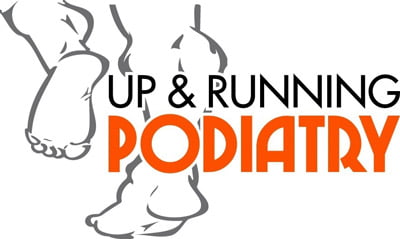Knee pain isn’t just a bother—it can seriously impact your daily life. Whether it’s a twinge while walking up stairs or a persistent ache that won’t let up, knee pain can slow you down and keep you from doing the things you love.
At Up & Running podiatry, we are passionate about helping our patients improve their quality of life. Understanding the underlying causes of knee pain can lead to effective treatment and a better quality of life.

Anatomy of the Knee
Let’s start by getting to know your knees a bit better. The knee joint is a remarkable piece of engineering, allowing us to bend, flex, and walk with ease. It’s made up of several key components working together, including bones, ligaments, tendons, and cartilage.
Ligaments are tough bands that hold the bones together, while cartilage acts like a cushion between them. Tendons connect muscles to bones, providing stability and control. With all these parts working harmoniously, your knees can perform a wide range of movements, from a simple step to a vigorous jump.

1st Cause: Osteoarthritis
One of the leading causes of knee pain is osteoarthritis, a condition that affects the cartilage—the protective tissue covering the ends of bones. As we age, the cartilage can wear away, causing bones to rub against each other, leading to pain, stiffness, and swelling. But age isn’t the only factor; obesity and previous knee injuries can also increase the risk of developing osteoarthritis.
If you notice joint stiffness, swelling, or aching pain that worsens with activity, it’s time to see a healthcare professional. They can diagnose osteoarthritis through physical exams and X-rays, and recommend treatments like pain relievers, physical therapy, or in severe cases, surgery.
2nd Cause: Patellofemoral Pain Syndrome
Sometimes, it’s not about the parts around the knee, but the kneecap itself. Patellofemoral Pain Syndrome occurs when the kneecap and the groove it slides in don’t align well. This can cause pain behind or around the kneecap, especially when walking up or down stairs or sitting for prolonged periods.
Risk factors include muscle imbalances, overuse, and poor alignment. The good news is that non-invasive treatments like physical therapy, targeted exercises, and orthotic shoe inserts can often relieve the discomfort and get you moving again.

3rd Cause: Ligament Injuries
Ligaments play a crucial role in knee stability, but they’re also prone to injury, especially in active individuals. Two ligaments commonly injured are the ACL (anterior cruciate ligament) and MCL (medial collateral ligament). Sudden twisting motions, like those in sports, or direct impacts can lead to tears in these ligaments.
The result? Pain, swelling, and a feeling of knee instability. If you’ve experienced a ligament injury, your doctor might suggest a combination of rest, physical therapy, and sometimes surgery to mend the torn ligament and restore knee function.
4th Cause: Meniscus Tears
Imagine your meniscus as the knee’s shock absorber—a tough, rubbery piece of cartilage that helps distribute weight and reduce friction. However, sudden twists or degenerative changes over time can lead to meniscus tears.
Symptoms often include pain, swelling, and even the sensation that your knee is catching or locking. A healthcare professional can diagnose a meniscus tear through imaging tests and recommend a treatment plan that may include rest, pain management, physical therapy, or surgery if necessary.

5th Cause: Bursitis
Bursae are tiny, fluid-filled sacs that cushion joints and reduce friction between moving parts. However, repetitive stress or direct trauma can lead to bursitis—a condition where these sacs become inflamed. In the knee, bursitis can cause localised pain and swelling.
Rest, icing, and anti-inflammatory medications can help manage the pain. If bursitis becomes chronic, your healthcare provider might recommend physical therapy to strengthen the muscles around the knee and improve its overall function.
Other Potential Causes of Knee Pain
While the top five causes we’ve discussed are common, there are other potential culprits too. Conditions like gout, rheumatoid arthritis, or infections can also lead to knee discomfort. This is why it’s essential to consult a healthcare professional if your knee pain persists, so they can accurately diagnose the issue and provide appropriate treatment.
Prevention and Lifestyle Tips for Healthy Knees
Prevention is indeed better than cure when it comes to knee pain. Maintaining a healthy weight reduces stress on your knees, so watch what you eat and stay active. Regular exercise, especially low-impact activities like swimming or cycling can help reduce impact on the knees. Regular gym and rehabilitation exercises can allow you to strengthen the muscles around your knees, providing added support.
Plus don’t underestimate the power of proper footwear—with the right shoes, you can avoid unnecessary strain on your knees. Lastly, using safe techniques while exercising or lifting heavy objects can protect your knees from accidental injury.
Summary
In a nutshell, knee pain can stem from various sources, but understanding its root causes empowers you to seek the right solutions. From osteoarthritis and ligament injuries to meniscus tears, patellofemoral pain syndrome, and bursitis, each cause comes with its set of symptoms and treatments.
Remember, early diagnosis and intervention are key to effective recovery. If knee pain persists, don’t hesitate to consult a medical professional for accurate guidance.
Regain your knee health by scheduling a consultation with us today. Visit us at Up & Running Podiatry to take the first step towards healthier feet!
Frequently Asked Questions (FAQs)
Can knee pain be a sign of a more serious condition?
Absolutely. Sometimes, knee pain can indicate underlying health issues that need attention.
How can I determine if my knee pain requires medical attention?
If your knee pain is severe, persistent, or limits your daily activities, consulting a doctor is wise.
What are the non-surgical treatment options for knee pain?
Physical therapy, exercises, footwear and/ or foot orthotics, medications, and lifestyle changes can often help without surgery.
Is knee pain only common in older adults?
No, knee pain can affect people of all ages due to various reasons.
Can knee pain be prevented through exercise and stretching?
Yes, regular exercise, strength training and proper stretching can help prevent knee pain by keeping your knee muscles and joints strong and flexible.
Are there any natural remedies or supplements that can help with knee pain?
Some natural remedies and supplements might provide relief, but always consult a healthcare professional before trying them.

